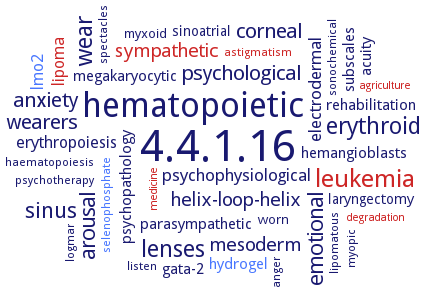4.4.1.16: selenocysteine lyase
This is an abbreviated version!
For detailed information about selenocysteine lyase, go to the full flat file.

Word Map on EC 4.4.1.16 
-
4.4.1.16
-
hematopoietic
-
leukemia
-
wear
-
erythroid
-
lenses
-
sinus
-
arousal
-
emotional
-
corneal
-
wearers
-
anxiety
-
psychological
-
helix-loop-helix
-
sympathetic
-
mesoderm
-
electrodermal
-
psychophysiological
-
lmo2
-
erythropoiesis
-
lipoma
-
acuity
-
gata-2
-
hydrogel
-
psychopathology
-
megakaryocytic
-
parasympathetic
-
subscales
-
rehabilitation
-
hemangioblasts
-
sinoatrial
-
laryngectomy
-
worn
-
myxoid
-
haematopoiesis
-
listen
-
logmar
-
psychotherapy
-
astigmatism
-
selenophosphate
-
sonochemical
-
anger
-
lipomatous
-
spectacles
-
myopic
-
medicine
-
degradation
-
agriculture
- 4.4.1.16
-
hematopoietic
- leukemia
-
wear
-
erythroid
- lenses
-
sinus
-
arousal
-
emotional
-
corneal
-
wearers
-
anxiety
-
psychological
-
helix-loop-helix
- sympathetic
- mesoderm
-
electrodermal
-
psychophysiological
- lmo2
-
erythropoiesis
- lipoma
-
acuity
-
gata-2
- hydrogel
-
psychopathology
- megakaryocytic
-
parasympathetic
-
subscales
-
rehabilitation
-
hemangioblasts
-
sinoatrial
-
laryngectomy
-
worn
-
myxoid
-
haematopoiesis
-
listen
-
logmar
-
psychotherapy
- astigmatism
- selenophosphate
-
sonochemical
-
anger
-
lipomatous
-
spectacles
-
myopic
- medicine
- degradation
- agriculture
Reaction
Synonyms
ABA3-NifS, cpSL, CsdB, L-selenocysteine selenide-lyase, More, SCL, Scly, Sec lyase, selenocysteine beta-lyase, selenocysteine lyase, selenocysteine reductase, SLC, SufS
ECTree
Advanced search results
General Information
General Information on EC 4.4.1.16 - selenocysteine lyase
Please wait a moment until all data is loaded. This message will disappear when all data is loaded.
malfunction
-
disruption of the selenocysteine lyase-mediated selenium recycling pathway leads to metabolic syndrome in mice affecting hepatic glucose and lipid homeostasis. Mice lacking the enzyme and raised on an Se-adequate diet exhibit hyperinsulinemia, hyperleptinemia, glucose intolerance, and hepatic steatosis, with increased hepatic oxidative stress, but maintain selenoprotein levels and circulating Se status. Insulin challenge of enyme KO mice results in attenuated Akt phosphorylation but does not decrease phosphorylation levels of AMP kinase alpha. Upon dietary Se restriction, enzyme KO animals develop several characteristics of metabolic syndrome, such as obesity, fatty liver, and hypercholesterolemia, with aggravated hyperleptinemia, hyperinsulinemia, and glucose intolerance. Hepatic glutathione peroxidase 1 and selenoprotein S production and circulating selenoprotein P levels are significantly diminished. Enzyme disruption increases the levels of insulin-signaling inhibitor insulin signaling inhibitor protein phosphatase 1B
metabolism
-
the enzyme is involved in selenocysteine biosynthesis. The interaction between selenocysteine lyase and selenophosphate synthetase occurs with a stoichiometry of 1:1
physiological function
additional information
the enzyme is involved in Fe-S cluster assembly in haloarchaea
physiological function
-
the enzyme is involved in Sec decomposition to salvage Se, e.g. from plasma glutathione peroxidase 3 and Sepp1 proteins, for selenoprotein production. Because insulin signaling inhibitor protein phosphatase 1B expression is regulated by Se levels, it is also possible that the hepatic Se decline in enzyme KO mice is driving the expression of insulin signaling inhibitor protein phosphatase 1B, suggesting that Se derived from Sec decomposition participates in insulin signaling inhibitor protein phosphatase 1B regulation
physiological function
-
the enzyme is involved in Fe-S cluster assembly in haloarchaea
-
the enzyme adopts the canonical fold type I structure of pyridoxal 5'-phosphate enzymes with an active site cysteine, C388
additional information
-
the enzyme adopts the canonical fold type I structure of pyridoxal 5'-phosphate enzymes with an active site cysteine, C388
additional information
-
the enzyme is involved in selenocysteine recovering from selenoproteins to be used for synthesis of new selenoproteins


 results (
results ( results (
results ( top
top






